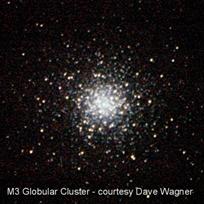LCAS Observer Challenge - May 2005 - Globular Clusters
Dave Wagner
Looking at the May-June Observer Challenge list, you'll see the basic Messier Object list is all about Globular Clusters. Some folks see these 'globs' as stellar dandelion puffs of stars, immense grand objects of the heavens. They are close enough to discern individual stars, but massive enough to awe the imagination. What would the night sky look like from a planet in the midst of a globular? What holds it so tightly together for so long?
Others folks see them as ho-hum fuzz balls, with too much 'sameness' to qualify for viewing time. They lack the unique patterns of an open cluster, the immense scale and wide variety of types and tilts provided by galaxies, the challenge of finding a faint nebula, or the excitement of viewing an exploded star. While the sameness of a globular is not as visually stimulating to everyone, perhaps we need to take a close look inside a globular cluster.

Globular clusters are basically gravitationally bound concentrations of perhaps ten thousand to one million stars, spread over a volume several tens to several hundred light years in diameter. It is this compact gravitational binding that has allowed them to survive as an entity for such a long time. Globulars are very, very old (with some exceptions) and are believed to have formed at the same time as the galaxy they surround. They reside in a halo about a galaxy, concentrated around the galactic center. This has proven a valuable fact. Since globulars are not evenly distributed about the earth, this observation led astronomers in 1917 to the recognition that our solar system was not at or near the center of our galaxy (it is 2.5 billion billion billion miles away from the center... they were not even close!).
So let's imagine just what it might be like, on a planet at the core of a globular cluster. First of all, we would be lucky to find that planet!
The nature of the formation and stability of the globulars have not been planet friendly! All that tight gravitational interaction and close star proximity may have swept away planets or planet forming materials long ago.
Alright then, let's say we found that rare planet towards the center of globular cluster M15, located in Pegasus. M15 is believed to contain 7,000 stars in a diameter of less than one light year. Recall that the closest star to our sun is at a distance of a little more than 4 light years! So, on earth, we have one star at over 4 light years in distance. On our rare planet in M15, we would have 3,600,000 stars in the same 4 light year radius! Can you imagine our night sky filled with thousands and thousands of stars, all as bright as Venus, every gap between them packed with a thousand stars more?!
I like observing globs, and when I view them I like to take a short trip there, even if it's just in my mind. What would the nights be like?! How many stars would shine even in the daytime on that distant world?! Go visit the web site of http://www.seds.org/~spider/spider/MWGC/mwgc.html for the SEDS listing of all 151 known GCs.





